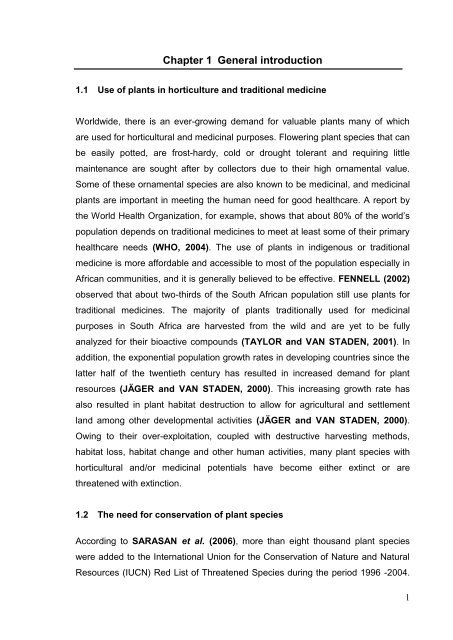Micropropagation and medicinal properties of Barleria greenii
Micropropagation and medicinal properties of Barleria greenii
Micropropagation and medicinal properties of Barleria greenii
Create successful ePaper yourself
Turn your PDF publications into a flip-book with our unique Google optimized e-Paper software.
Chapter 1 General introduction<br />
1.1 Use <strong>of</strong> plants in horticulture <strong>and</strong> traditional medicine<br />
Worldwide, there is an ever-growing dem<strong>and</strong> for valuable plants many <strong>of</strong> which<br />
are used for horticultural <strong>and</strong> <strong>medicinal</strong> purposes. Flowering plant species that can<br />
be easily potted, are frost-hardy, cold or drought tolerant <strong>and</strong> requiring little<br />
maintenance are sought after by collectors due to their high ornamental value.<br />
Some <strong>of</strong> these ornamental species are also known to be <strong>medicinal</strong>, <strong>and</strong> <strong>medicinal</strong><br />
plants are important in meeting the human need for good healthcare. A report by<br />
the World Health Organization, for example, shows that about 80% <strong>of</strong> the world‟s<br />
population depends on traditional medicines to meet at least some <strong>of</strong> their primary<br />
healthcare needs (WHO, 2004). The use <strong>of</strong> plants in indigenous or traditional<br />
medicine is more affordable <strong>and</strong> accessible to most <strong>of</strong> the population especially in<br />
African communities, <strong>and</strong> it is generally believed to be effective. FENNELL (2002)<br />
observed that about two-thirds <strong>of</strong> the South African population still use plants for<br />
traditional medicines. The majority <strong>of</strong> plants traditionally used for <strong>medicinal</strong><br />
purposes in South Africa are harvested from the wild <strong>and</strong> are yet to be fully<br />
analyzed for their bioactive compounds (TAYLOR <strong>and</strong> VAN STADEN, 2001). In<br />
addition, the exponential population growth rates in developing countries since the<br />
latter half <strong>of</strong> the twentieth century has resulted in increased dem<strong>and</strong> for plant<br />
resources (JÄGER <strong>and</strong> VAN STADEN, 2000). This increasing growth rate has<br />
also resulted in plant habitat destruction to allow for agricultural <strong>and</strong> settlement<br />
l<strong>and</strong> among other developmental activities (JÄGER <strong>and</strong> VAN STADEN, 2000).<br />
Owing to their over-exploitation, coupled with destructive harvesting methods,<br />
habitat loss, habitat change <strong>and</strong> other human activities, many plant species with<br />
horticultural <strong>and</strong>/or <strong>medicinal</strong> potentials have become either extinct or are<br />
threatened with extinction.<br />
1.2 The need for conservation <strong>of</strong> plant species<br />
According to SARASAN et al. (2006), more than eight thous<strong>and</strong> plant species<br />
were added to the International Union for the Conservation <strong>of</strong> Nature <strong>and</strong> Natural<br />
Resources (IUCN) Red List <strong>of</strong> Threatened Species during the period 1996 -2004.<br />
1

















